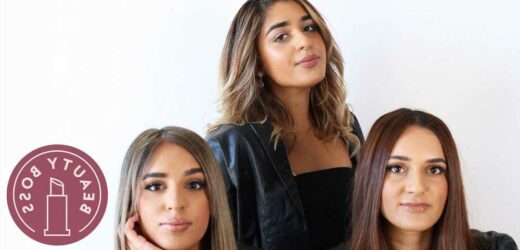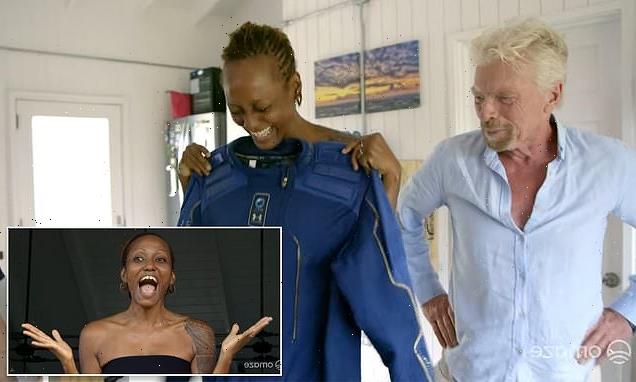Aleena, Aleezeh, and Naseeha Khan are three Pakistani sisters who never thought they'd start a makeup brand.
However, after continuously feeling under and misrepresented in the beauty world, they decided to take matters into their own hands, and CTZN Cosmetics, a collection focused on championing people of color and all underrepresented communities, was born.
"The conversation developed when we realized the beauty industry was still defining inclusivity as women of color only, when in fact, other genders, ages, sexualities, and skin types feel completely excluded," says Aleena, the co-founder who leads branding and marketing.
The brand originally launched with 25 shades of their Nudiversal Lip Duo, a dual-sided lip product that features a matte lipstick on one end and matching lip gloss on the other. The wide selection of shades got a lot of attention from beauty consumers, including beauty influencer Mikayla Nogueira, who recently made a video raving about the lipstick on TikTok. Her video (along with others) went viral causing a surge of beauty lovers to crash the CTZN Cosmetics site in hopes of finding their perfect shade of nude.
Ahead, we spoke with the founders to talk about the inspiration behind the brand and the importance of representation in the beauty industry.
What inspired you to create the brand and what's it like being in business with your sisters?
The entire CTZN concept was born from personally experiencing the inequality within the customer shopping experience in the beauty industry. My sisters and I weren't willing to accept the normalization of one demographic having to struggle harder than others to find their products while also not feeling represented by campaigns or considered within shade ranges. As Pakistanis, we felt that the middle brown skin tone was rarely represented by the South Asian or Middle Eastern complexions seen on beauty campaigns. My sisters and I had to work harder to find our correct undertones, constantly mixing shades to achieve the perfect shade. Our friends of color shared a similar sentiment and started opening up about their personal experiences in various industries.
We remember being horrified that one of our friends, a Black model, explained that a model with a fairer complexion can arrive to set having full faith she will be taken care of, whereas a Black model has to bring her products to set, accepting that more-than-likely the artist on set will not be equipped to work with her complexion. So, we set out to create a brand that empowers all citizens of the world to feel seen, guaranteeing a perfect shade for every skin tone with every collection we create.
What's it like being in business as sisters?
Working with sisters is what you imagine it to be. You argue about insignificant things, you don't talk to each other the way you would talk to formal colleagues (imagine that), but at the end of the day, it's the most sacred feeling to keep something in the family. The best part about being in business together is that nobody feels alone in the process and although we may disagree, we are all on the same page about the vision of the brand, and nothing matters more than that alignment.
Why did you choose to launch the brand with lipsticks?
When we started developing the brand in 2017, two years before we launched, it was the age of the lip kit. Everyone was obsessed with liquid lipsticks and matte lip finishes, but they found the formulations dry.
We felt that the lip category had not yet been disrupted, in the lens of inclusion, compared to foundations and concealers. As a new brand, we did not want to launch a product that people had already seen, so we decided to focus on the nude lip category since it aligned with our concept of guaranteeing shades for all skin tones. We realized that the beauty industry was still defining nude as beige and disregarded true nude shades for all other complexions and lip tones, which is why we created 25 shades of nude. We always say that someone may find their correct nude lipstick elsewhere, but other brands will call it a dark brown lipstick, whereas CTZN acknowledges it as a nude.
Can you tell us about the process of creating the shades of lipsticks? Was it difficult? What goes into creating nude tones for every skin color?
There were so many steps involved in the process, especially as it was our very first time developing a cosmetics range. We started with a survey sent out to hundreds of beauty consumers around the world and asked what their favorite nude lipstick was and what they would tweak about their favorite shade or formulation. This was integral in starting with benchmark shades that people already loved, but we were still looking to adjust slightly. We then spent weeks on YouTube and Instagram, jotting down which nude lip products got positive reviews by key vloggers, including which products they did not rate highly. We did a lot of the field research ourselves.
Based on the initial research and development, we narrowed it down to 25 shades. We worked with our manufacturer to ensure the formulations were cruelty-free, vegan-friendly, and had a high color payoff. After receiving our samples, we tested the shades for months on friends and volunteers of different skin tones. Testing on a variety of complexions and lip tones was absolutely everything for this process!
VIDEO: The 10 Lipstick Colors to Try This Fall
With the rise of the pandemic, a lot of makeup brands took a hit from people not wearing makeup, especially lipsticks due to masks. How did you pivot your business during the pandemic and what did you learn from this experience?
We instantly felt insensitive marketing lip products heavily, so we focused more on community building. We initiated Instagram lives with celebrity makeup artists, stepping outside of our comfort zone as we had not been in front of the camera much until the pandemic. We also replaced our Tuesday marketing email with a new email segment called "CTZN Connect" and highlighted someone from around the world, and had them engage with Q&As that allowed others to learn about a new culture. The most beautiful moment for us was creating content titled "Positive Reflections I Had During Quarantine," where we got user video submissions from various countries and continents to find positivity in a time of crisis.
Our intention for all of this was to show our personalities and build a personal connection with our CTZN family.
On a product level, we pivoted to the eye category and started developing a universally flattering eye shimmer, since lip sales correlated with COVID rules on masks. The pandemic taught us how unpredictable external influences are and the importance of being reactive rather than monotonously sticking to a marketing calendar.
As three women of color with a brand all about cultural awareness and breaking gender stereotypes, what do you hope for the future of the beauty industry?
We hope that inclusive shade ranges become the norm. Brands need to be testing all products on the individuals they are trying to create the shade for, collect their feedback, and include them in the conversation rather than assuming what they want.
Also, if a brand wants to create a campaign promoting an ethnic occasion or holiday, we hope that the brands consult people from that group and that their campaign or promotion benefits the targeted community. There is nothing worse than appropriating a culture or making someone feel that they are just a checkmark in a marketing brief.
We also hope beauty brands show interest in using their powerful platforms for more than just product awareness. We created a social media segment called "culture-torial", where you learn about someone's culture while they do their makeup routine, and we want to continue to innovate more ways that we can educate through beauty. Last but not least, we hope to see more diverse teams behind each brand. In a time of cancel culture, one way that we can avoid unintentionally offending a group of people is by ensuring we are analyzing our concepts and ideas from multiple perspectives, rather than only consulting our internal peer groups, which are often people very similar to our demographics. Run your core ideas by a diverse team of varied ages, genders, ethnicities, and sexualities.
Beauty Boss profiles the brains behind the brands making waves in the beauty industry. From the ideas that first inspire brands to how best-selling hair, makeup, and skincare products are made, find out how these leaders get it done.
Source: Read Full Article


